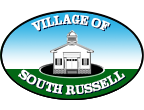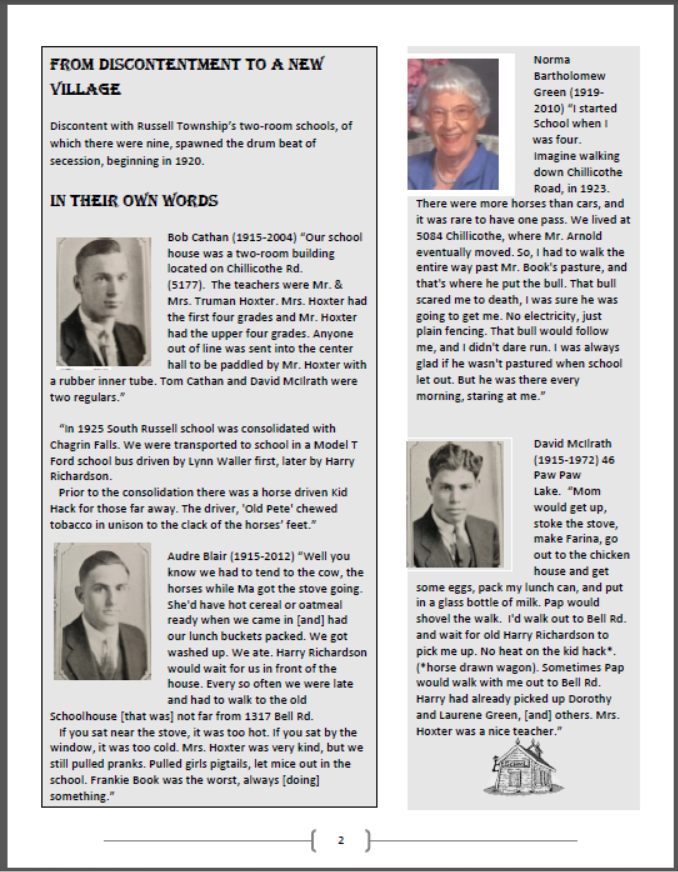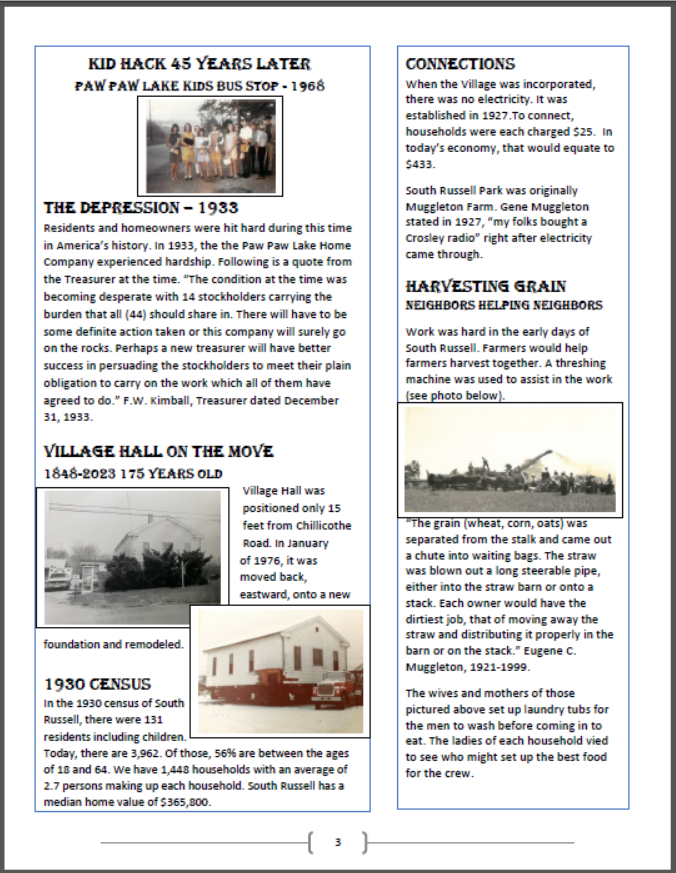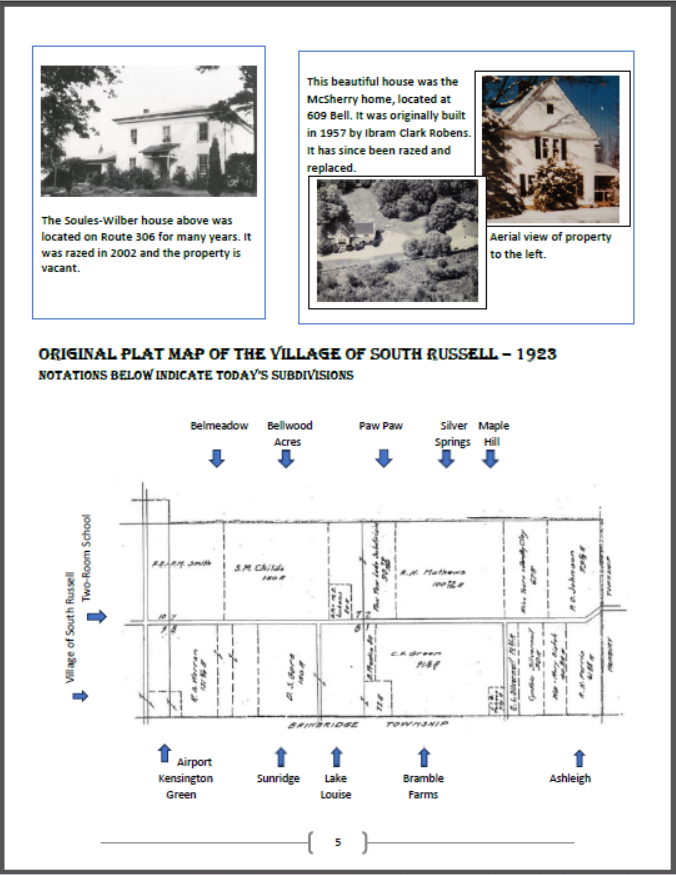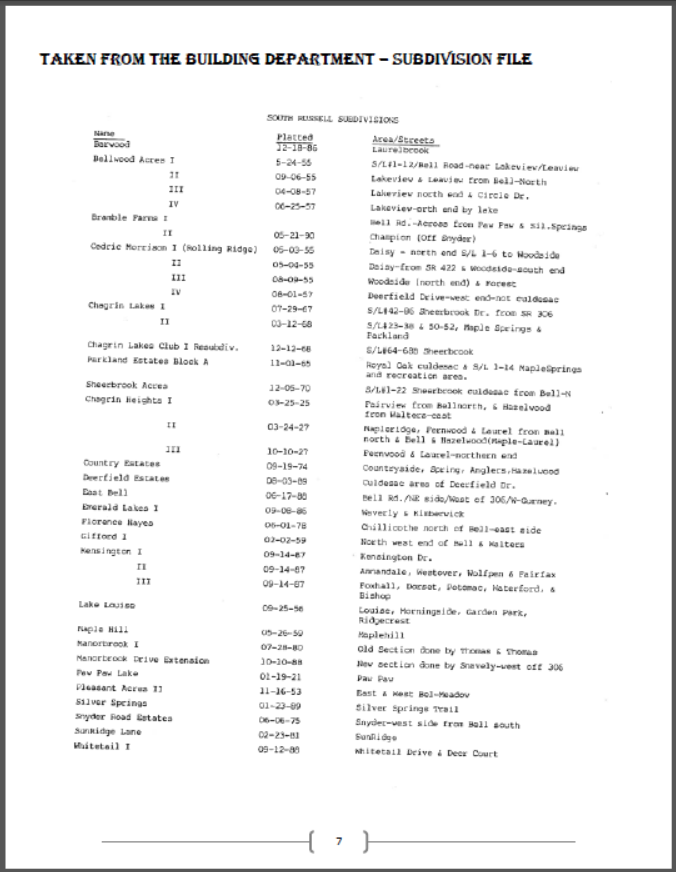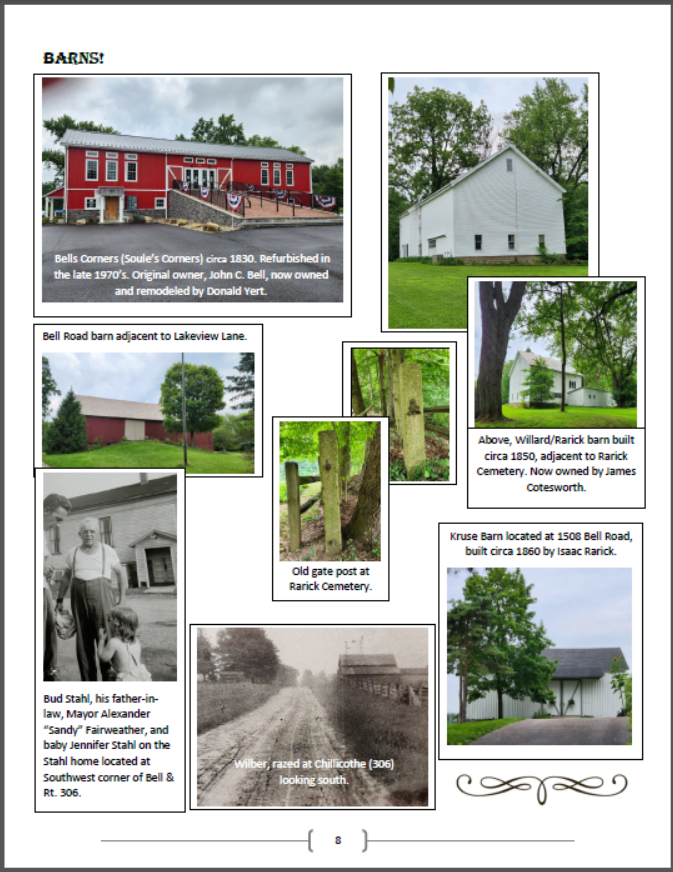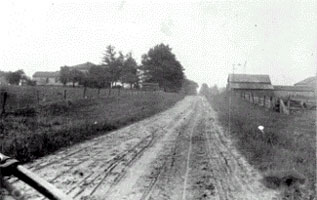Download
The Village of South Russell
Centennial Booklet
Village of South Russell Centennial 1923-2023
South Russell Village – A Brief History
Patricia and Phillip Wayne Hosmer
Written: Spring – 1992
Russell Township was the last township settled in Geauga County. In 1818, Gideon Russell, wife and children Ebenezer, William, Aipheus, Jemima and Sally moved into the thick woods of township number seven, range nine in the Connecticut Western Reserve on the rudimentary Chillicothe Road a little south of the center of the township. For about two years they were the only inhabitants of Russell, which the people of Newbury called the West Woods. In the fall of 1820, Simeon Norton, wife Sally and daughter Melinda built a split and hewed log house on the north part of the Russell farm. This house was sixty rods or more back from the road near a good spring and not far from the road that had been laid out from Cleveland to Warren and was partially open to travelers. On March 31, 1821, Orson Norton was born, the first known birth in Russell.
The Chillicothe Road (now state route 306) was laid out in 1802 when Chillicothe was the seat of the territorial government of Ohio. General Edward Paine was one of the committee who laid out the road. It began at Painesville and ran through Mentor, Kirtland, Chester and Russell. It was said at the time it followed an Indian trail.
Soule’s Corners (Bell Road and Chillicothe Road) received its name from the family of the three brothers, A. L., Myron and Benjamin Soule who came to Russell in 1839 from Onondaga County, New York,
Soule’s Corners (Bell Road and Chillicothe Road) looking south
and built a home near the corners of Chillicothe and Soule’s Corners Road (now Bell Road). Later one more road in the area was laid out, McKin1ey, which ran south of Soule’s Corners Road to the Bainbridge line and today is Snyder Road.
Population growth was slow in this area, but in 1843 Harry Burnett arrived with his wife and son and built on what is today the “Old Silsby property.” Elder Willard, a Baptist minister, owned a farm on Soule’s Corners Road about two miles east of the Chagrin line. His young son, Archibald, evidently covered the walls of the home with drawings and paintings, which remained for many years after he sold the property to Isaac Rarick about 1850. We know this precocious boy as the future painter of the most famous American historical painting- the “Spirit of 76”. He was fourteen when his father sold the farm.
Several early families have tended to live in their homes for several generations. The Warren Green family lived in the home built by their uncle Isaac Rarick on Bell Road; Green’s son lived there until his death around 1948, aged ninety, and Dorothy Green Matthews, son William and daughter Joan (LaRue) also lived in this house. R. Albert Warren, South Russell’s first mayor, lived in the house where he had been born for over eighty years before his death in 1960. The house had been built in 1861 by his father, Joel Warren, and was close to the farm where Joel’s father, Tabor Warren, settled in 1831. The home was demolished some time after the farm became Chagrin Falls Airport. The Wilber family lived on property sold to Ithel Wilber, and at the writing of the first village history in 1963, six generations of Wilbers had lived in the beautiful home on Chillicothe Road. In 1864 Alexander McLaughlin bought land next to the Wilbers and moved into a home that had been built in 1840. In 1940 this became the home of Lillian McLaughlin and Laura McLaughlin Bezdek who were descendants of famous Geauga author and statesman, Albert Gallatin Riddle. Last of the known names of early settlers is Parley Wilder, who lived to a great age, and built and lived on what was then known as the Silvernail farm.
It was generally believed there was an underground railroad station before the Civil War on the Isaac Rarick farm next to the cemetery on Bell Road. In Rarick’s barn was a room hidden where hay was put down for his cows. Rarick would drive to neighboring towns to pick up slaves, place them in the bottom of his wagon and pile a load of hay on top. The slaves were secreted in the hidden room and he would take the wagon to the next farm, owned in 1992 by Eugene Muggleton, leave the wagon, and change his clothes before returning home. The following day the slaves would be driven to the next station on their way to Lake Erie, Canada and freedom. While carpenters were building the R. A. Warren house, one worker, Joseph Harpham related southern planters with bloodhounds came on the premises in search of slaves who were reported in the neighborhood. Neighbors aided the planters in their search by directing them in the opposite direction of the Rarick farm.
General farming seemed to be the occupation of almost all the early settlers. The Union Cheese Factory, built in 1871, was about one mile east of Soule’s Corners on the north side of the road. Stockholders were R. U. Roberts, Nark Matthews, Isaac Rarick and others because not one of them could have raised the cost of the building themselves. The first industry in what would become South Russell cost $2,733.72! The cheese produced there sold for five to seven and a half cents a pound. Evidently no record exists of how long this business was in operation.
The building of the Cleveland and Eastern Electric Railway in the 1890’s brought many changes to rural Geauga County. The future South Russell laid on and between the two lines going east from Cleveland. Closest to them was the Chagrin Falls, Hiram and Garrettsville division with part of its line along the southern boundary of our village. Remains of the right of way are still visible along Bell Road in Newbury. The northern line was the Gates Mills, Chardon, Burton and Middlefield division. These interurban electric car lines were a great advantage to Geauga farmers, but in little more than twenty-five years they were crowded out by improved roads and that new invention-automobiles and trucks.
Russell Township had nine school districts by the 1880’s; two of these were located in what is now our village. School district number two, the Gore, was on the corner of McKinley (Snyder) and Soule’s Corner Road (Bell). When this school was no longer needed, the building was moved back and converted into a home by a man named Farmer. In 1930, the Dellners bought the house and later built an addition to the home, which still stands on Bell Road. The second South Russell school was on Chillicothe Road, just north of the corners and was known as district number six. It was first a one-room school and later a two-room school when district number seven building was moved from Walters Road and joined to it. Mr. and Mrs. Truman Hoxter of Chagrin Falls were in command at this school. Their work was highly satisfactory and they were later hired to teach in Russell’s centralized school. This building, now converted into a home, is at 5177 Chillicothe Road. Harry Modroo, of the Hemlock Road farm, attended first grade here in 1924-25 before the Russell School building near route 87 was built.
Around 1900 the question of school centralization came up, was voted on by Russell inhabitants, and was defeated. This happened several times and finally in 1923, after a heated campaign, the vote carried. Even then the majority of Russell Board of Education was bitter against centralization and would not vote to issue bonds to build a school. That fall the terms of office of two board members expired and other favorable to the issue were elected, another resigned, and by spring, 1924, the bonds were sold and the building contract let. In the fall of 1925 students began attending the new school. But the damage had been done by the bitterness engendered by the long arguments. The southern part of the township had incorporated early in 1923 as South Russell Village and had asked for annexation to Chagrin Falls School District and had been accepted. South Russell students began attending Chagrin Falls Schools in 1926. Thus South Russell was born in controversy over educational issues, proving that still, as over one hundred years before, people in the Western Reserve considered a good education paramount. After World War II, rapid growth in South Russell led to the opening in 1966 of Gurney Elementary School on Bell Road.
South Russell Cemetery is located on Bell Road, west of Chillicothe Road, One half acre was purchased from S. R. Willard on November 15, 1849, for forty dollars. It was enlarged in 1863 by two rods of property on the south side purchased from Isaac Rarick for ten dollars. Stephen Loesy, who was killed by having a tree fall on him while he was chopping, was the first burial there. This cemetery was the first public burial grounds in Russell. The first few decades of settlement, the few burials occurring were mostly on family burial plots. The last burials were former mayor Charles Reiss and his son David in the 1970’s.
South Russell Grange, the ninth in Geauga County, was organized July 1, 1948, with sixty-seven charter members. Kenneth Blair was the first master. This grange was active until the mid 1970’s when it joined with Auburn Grange, which continues today. An earlier grange in the southern part of Russell was organized in 1874 with forty members. They met in the Chamberlain home (Modroo Farm) on Walters Road.
Although it is now very suburban in character, South Russell has an abundance of wildlife. In the wetlands area of Emerald Lakes, beavers created a dam and surrounding pond, which expanded rapidly. The beavers were trapped and removed in 1991 because they were cutting down some ornamental trees near the watershed and the developer wished to begin work on Emerald Lakes II. Raccoons, rabbits, squirrels and other small animals are plentiful and deer still live in the remaining wild areas. The interaction of the increasing human population on the natural wildlife in the area will continue to cause friction.
The first meeting of the new South Russell Council was held on February 22, 1924, at which time a bond for new mayor, R. Albert Warren, was filed with council. Council members were Messrs, Robinson, Smith, Cathan, Silsby, Muggleton and McLaughlin. Wade McIlrath was the first village clerk. A newly graduated law student, Frank J. Lausche, was the first solicitor.
The first official planning board meeting was held in 1942 with 0. A. Kellner as chairman and it was then that an ordinance incorporating a building code was introduced. The board had little activity until 1953 when John Robeck became chairman and the first building codebook was printed.
As the village and the surrounding area grew, a street commissioner and a village planning board were organized, the architectural board of review set up, the zoning board and zoning board of appeals developed. A fire prevention officer was added in 1981. Durward Bezdek became the village’s first appointee as a trustee of the Geauga County Historical Society.
In early 1992 as this is written, South Russell is on a very sound financial footing. This year’s budget, not yet final, has a total expected revenue for 1991 of $1,275,803. The revenues for 1987 were $963,582, so increase of revenue has been rapid. Each year the village has had a small surplus, which is placed in a reserve fund. The only current financial problem is that of non-payment of the village income tax by residents who either are purposely-withholding payment or who mistakenly believe they live in Chagrin Falls (our post office address) and paid their taxes through the RITA collection agency to Chagrin instead of through the Central Collection Agency for South Russell. Treasurer Thomas Welch is taking steps to insure compliance, but at this time one hundred four residents have not paid taxes due. Chagrin Falls has refunded monies mistakenly paid to them. In an appendix at the end of this account is a copy of the sources of village revenue and the listed expenses for the years 1987-1990 as furnished by the village treasurer.
As we look ahead in 1992, it appears growth in South Russell is slowing. Little vacant property remains in the developed areas but growth is expected on the west side of Emerald Lakes I along the north side of Bell Road as work has begun on clearing the land. Issues now before council include the pressing need for a turning lane at the intersection of Bell Road and Chillicothe Road where traffic is increasingly heavy. This work will be done in 1992. Many citizens of South Russell as well as Chagrin would like to see the development of a bike path along Bell Road. Financing for this path is being studied. South Russell was one of the first to vote in favor of Geauga County’s development of an E-911 service, which is badly needed in the county. Implementation is to be begun this year. At this time it appears this service will be financed by a .25% piggyback sales tax within the county.
As in many places, water may be a problem in the village. The western area has had city water from Chagrin Falls for many years, and in the early 1980’s joined the McFarland Sewer District. Paw Paw Lake residents have their own water system, as do some other areas. The remainder of South Russell is served by individual wells. East of Bel Meadow and Kensington Green, residences have septic tanks; the remainder of the village is in the McFarland Sewer District. During the drought of 1938, one area had several residences with wells nearly dry. At village hall, the well is currently contaminated and workers drink bottled water. Future water needs are being studied and evaluated.
Traffic increases constantly with growth not only in South Russell but also in neighboring townships and villages. The opening of new Route 422 has created heavy traffic not only on route 306 but also on secondary roads in and around the village. Easier access to Cleveland and to Youngstown has brought the threat of more crime to the county and to this affluent village. Our police department is cognizant of this. At this writing, Chagrin Falls Police Department is the dispatch service for South Russell for police, fire, and ambulance service. South Russell is served currently by Chagrin Falls Suburban Fire Department under a yearly contract.
South Russell has grown from a small, isolated farming area in the middle 1800’s into a fashionable address and a pleasant village as we near the twenty-first century. Open space is gone, but residents still have the “feel” of country. An active and energetic mayor and council are aware of current and future problems with traffic and water supply. Commercial and residential development is carefully evaluated and controlled. Population density will not increase appreciably after the latest development is completed. South Russell remains a fine place to live in Ohio’s most affluent and great county-Geauga.
South Russell Village – A Brief History Part 2
By Pat Hosmer
Written: December 29, 2000
Disputes over education created South Russell Village. Residents in the southern part of Russell Township had long wanted one large building to replace many one-room schools. They had petitioned the Russell Board of Education repeatedly and been turned down. In 1923 these residents seceded and formed South Russell Village. They also petitioned to be accepted into the Chagrin Falls school system and students began attending Chagrin Schools in 1925.
Russell Township was settled in 1818 by settlers from New England and was called the “West Woods.” Farming, cheese making, and the service industries of the day-grist mills, saw mills, a blacksmith shop were local businesses.
There was little growth until the interurban came along in the early twentieth century; after World War I, roads improved. Automobiles became more common, and the scattered farmhouses gave way to residential developments, many around lakes, with Paw Paw Lake leading the way. Most growth came during the period after 1970.
The most famous business in the village was Chagrin Falls Airport located where Kensington Green now is. Many famous Americans visited or flew into this airport and hundreds of pilots trained there during and after World War II.
Lovely South Russell today is almost completely residential with several small areas zoned for light business. Zoning is strict and village services are excellent. Satisfied residents support the village wholeheartedly.
